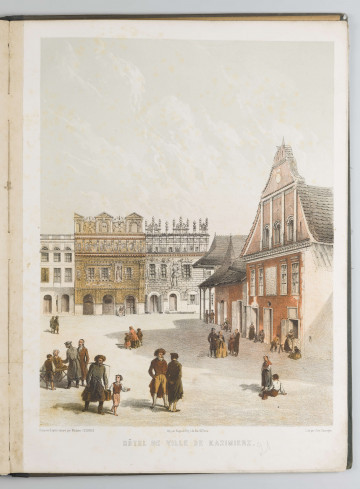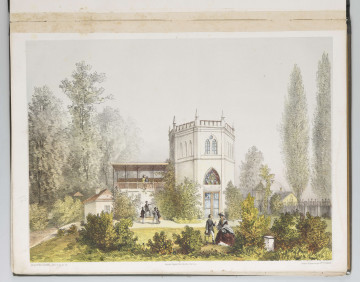
Hotel de ville de Kazimierz
1860
National Museum in Lublin
Part of the collection: Lubliniana. Painting views of Lublin and the Lublin Region (17th–early 20th c.)
The card with the atmospheric landscape comes from a lithographic album Album des vues de l'Institut Alexandra du jardin et des environs de Novo Alexandra (Puławy), published in Paris in 1858. The author of the twenty-four drawing and watercolour prototypes was Barbara Czernof, a drawing teacher at the Alexandria Institute for the Education of Ladies. The Tsarist educational establishment functioned in the Czartoryski family's Pulawy estate, called New Alexandria, which was occupied by the Russians after 1831. In the 1850s, the artist produced many works showing the corners of the former residence and views of the surrounding area: Parchatka, Kazimierz, Janowiec. The Parisian publication is the only surviving sample of Czernof's work, testifying to her great talent and skills.
The lithograph depicts a landscape from the surroundings of Janowiec. A small settlement with a huge castle, located in the Vistula river basin opposite Kazimierz Dolny, not far from Puławy, has long attracted tourists looking for beautiful places with an interesting history. The castle was erected at the beginning of the 16th century as a powerful defensive fortification. Eminent architects - Santi Gucci and Tylman of Gameren - participated in subsequent stages of the construction. The history of this impressive at that time seat, furnished according to the best European models, was connected to the leading magnate families of the Republic of Poland: The history of this impressive seat, furnished according to the best European designs, was connected to the leading magnate families of Poland: the Firlej, the Tarns, the Lubomirskis. It was the venue of meetings attended by Sigismund the Old, Bona Sforza and Sigismund III Vasa. Jan Kochanowski, who settled in nearby Czarnolesie, was a frequent guest here. After the middle of the 18th century, the castle lost its importance, and in the 19th century it turned into a ruin.
The massive building on the Vistula escarpment with the village at its foot is shown from a distant perspective, from the lower, further bank of the river. The foreground is occupied by a wide stretch of water on which a boat with sails carrying tourists is floating. Further away, reaching the border of the settlement, is a vast meadow with tiny figures of walkers and people riding on horse-drawn carts. The meadow slopes gently to the top of the hill. The simple shape of the castle, diversified by the vertical line of high bastions, is clearly visible against the background of the sky covered by delicate clouds. In the valley you can see village buildings drowning in lush greenery: a small Gothic-Renaissance church and similar small houses.
Author / creator
Dimensions
cały obiekt: height: 27,9 cm, width: 40,2 cm
Object type
graphics
Technique
lithography
Material
cardboard
Creation time / dating
Creation / finding place
Owner
The National Museum in Lublin
Identification number
Location / status

1860
National Museum in Lublin

1860
National Museum in Lublin

1860
National Museum in Lublin
DISCOVER this TOPIC
Museum of King Jan III's Palace at Wilanów
DISCOVER this PATH
Educational path